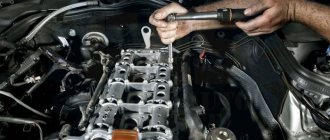Every car requires attention and needs full care. Be sure to fill the engine with oil. Without this product, the unit will not be able to fully operate. If the driver takes care of his vehicle and fills in the right oil on time, then the car will last a long time.
During vehicle operation, all important functional components wear out. To protect the motor from the negative effects of external factors, it is enough to change the lubricant at a certain time. This is where the fun begins. I was faced with the fact that not everyone knows at what mileage and how often the oil should be changed. Let's talk about this.
What is meant by car tuning?
Almost everyone has heard the term “tune-up” in relation to a car. But don’t think that in this case we are talking only about changing the oil and cleaning the windshield. Adjustment refers to a much wider range of work, namely checking various components of the car and replacing them in case of excessive wear. We're talking components like the distributor cap, fuel filter, positive crankcase ventilation (PCV) valve, air filter, spark plugs, brakes, hoses, belts, and wiring. Qualified auto repair shop personnel also check idle speed, idle mixture, sensors, and ignition timing. If any problems are discovered, they must be corrected.
Source
The main thing not to miss: how to understand when to change the engine oil?
There is an opinion that it is necessary to change the engine oil as often as possible. However, the cost of high-quality oil and the expense of replacing it discourage any desire to carry out this procedure frequently. Every driver sooner or later asks the question: when is it necessary to change the oil? Some people change the oil with the arrival of winter, others with the arrival of summer, and others wait for the “round” number on the odometer. It is much easier to focus on the light on the dashboard, which indicates that it is time to change the oil. In this case, not only kilometers are taken into account, but also engine hours.
In general, the engine is a fairly patient thing. And, if you create an optimal environment: low speed, adequate load and ensure operation without overheating, then it will be able to work much longer than the manufacturer intended. However, in real life this happens extremely rarely. Constant overheating and cooling significantly worsen the condition of motor oil, the quality of which decreases from the second it is poured from the canister into the engine. Oxidation begins immediately, dirt gradually accumulates, and detergent additives disappear. This is due to the normal reaction of the oil to engine operation. At the same time, the oil must not only lubricate and maintain normal engine temperature, but also flush the power units, removing all kinds of impurities from them.
Obviously, the older the oil, the worse it copes with its functions. Low-quality oil does not reduce friction, interfering with the operation of moving engine parts, which begins to work intermittently and then stalls altogether. In this regard, it is extremely important to change the oil in a timely manner. As a rule, scheduled oil changes are performed every 10,000 kilometers. However, the value of this indicator is formal. In reality, engine operating conditions play a key role in the need for an oil change. The worse they are, the more often you will have to change the oil.
Particular attention to the frequency of oil changes should be given to drivers who often drive on bad roads and off-road. In addition, the quality of the oil is directly affected by the high dust content in the air, transportation of large loads and operation of the vehicle under conditions of sudden temperature changes. In such cases, you need to think about changing the oil every 7,000 kilometers.
Conclusion
In this article, I cited one of the factors that influences how often you need to change the oil in a car engine. But other conditions related to the features of modern engines were not taken into account, such as:
- Increased temperature conditions of the power unit;
- Constructive failures;
- Oil quality.
And much more. This is individual for each manufacturer. Therefore, in order not to bother with calculating engine hours and mileage, many club services recommend changing the engine oil at least every 7-7.5 thousand km
. This way you will avoid many problems with the operation and repair of the internal combustion engine.
If I was wrong, write about it in the comments. The article was useful - like it. Good luck to everyone on the roads!
Source
Signs indicating the need for an oil change
Experienced car owners clearly know how often the oil needs to be changed. The following signs help them navigate:
One way or another, the service life of any vehicle directly depends on careful treatment of the engine. Timely oil changes are one of the key components of such care. In this regard, it is very important to regularly change the oil and monitor its condition. You should not blindly trust the established regulations, which provide for an oil change after a mileage of 10-15 thousand kilometers. In each individual case, its own optimal interval is determined. These are only approximate figures and should not be relied upon.
An important role in the process of monitoring oil quality is played by: the service life and technical condition of the vehicle, fuel quality, type of engine oil, and recommendations of the vehicle manufacturer. Obviously, in a new car the oil will be changed much less frequently than in an old one. At the same time, the operating conditions of the car will play a secondary role. Over the years, a car of any brand begins to burn oil faster. This is another reason for owners of older cars to think about the frequency of checking their engine fluid. As already mentioned, the interval between changing fuel and lubricants depends on the operating conditions of the vehicle. In fact, this is one of the key factors affecting the quality of the oil. It makes no sense to change the oil based solely on the number of kilometers traveled. In order to choose the optimal frequency, you should study the slightest nuances of the engine and its operating conditions.
Oil selection
In this matter, it is best to follow the manufacturer’s advice, because it is with a specific type that the factory guarantees the best engine performance. A list of recommended fluids for replacement is located at the end of the vehicle's owner's manual. It is recommended to fill the VAZ 2114 car with semi-synthetic with a viscosity of 10W-40. Which specific manufacturer to choose is a personal matter for the motorist. But it should be taken into account that you will have to pay a large amount for a promoted brand (after all, advertising costs a lot of money).
What affects the oil change interval?
Typically, there are five main factors:
Let's look at each factor in more detail.
Technical condition of the car
In a new car, oil will, of course, be used much more economically than in an old one. With age, a car of any brand inevitably begins to burn it, and this does not at all depend on the conditions of its operation. This means that owners of older cars need to spend more time checking the engine fluid level. The optimal check interval is several hundred kilometers.
Features of car operation
Fuel quality
The quality of fuel has a very strong influence on the interval between replacing old oil in a car with new one. Experts especially recommend paying attention to the sulfur content. If gasoline has more than 50 ppm of sulfur, then it is better not to use it for a passenger car. The thing is that such fuel, when burned in an engine, can form sulfur oxides, which are then converted into sulfuric acid. This acid enters the car oil and oxidizes it. The more acid, the worse the properties of the liquid will become.
Type of motor oil
The modern automotive market can offer hundreds of different types of consumables. They will differ in their composition, brand, manufacturer and, of course, each of them will have its own replacement interval. Let's look at the types of oils and their optimal service life.
Semi-synthetics
Today, real mineral fuels and lubricants for cars are practically not found. They have been replaced by semi-synthetic ones, which have a high level of additives. Among such motor oils one cannot find “long-lived” ones, and their breakdown products quickly pollute the car’s engine. This means that these working fluids need to be changed quite often - approximately once every 10 thousand kilometers.
Hydrocracking
Many experts consider this product better than semi-synthetics, but not by much. The only positive differences are the ability to control additives and some stability in viscosity. As for the question of when it is necessary to change such oil, today experts cannot give a definite answer. But, as practice shows, it can work up to thirty thousand kilometers! In this case, much will depend on the quality of the fuel and the car’s engine.
Oils based on polyalphaolefins
This motor oil is an important component of consumables used for racing cars. The cost of such a product is much higher than the previous ones, but this is easily explained by its high characteristics. Firstly, this consumable material has improved fluidity, and secondly, it can be used at very low temperatures. Taking this into account, we can say with confidence that the service life of such a product will be quite long. As a rule, its change interval exceeds 400 standard operating hours.
Esteraceae
These oils are not used very often in practice, as they are expensive. However, they are considered one of the best in many respects. This motor oil has low boiling point, durable film, low friction coefficient and good cleaning properties. It is very difficult to answer the main question - when it is necessary to change such oil, because many experts have different points of view here. Purely theoretically, the service life of this product is very long, but given the characteristics of real operating conditions and the low content of additives in the composition, it cannot be used even for the standard 15 thousand kilometers.
Polyglycol
These consumables are considered the most progressive. They have a low coefficient of friction, excellent additive stability and are gentle on rubber parts. Thanks to these qualities, the service life of the working fluid is significantly higher than standard values. However, unfortunately, it is very difficult to find oils of this type on the modern market, and their price is not the lowest.
Having analyzed all of the above, we can summarize that motor oils can differ very significantly from each other. Different types of fuels and lubricants have different sets of additives, distinctive characteristics and capabilities. That is why each of them needs to be changed in due time. Standard drain intervals are calculated only for semi-synthetic and synthetic oils with hydrocracked base oils. When a car uses a different type of fluid, the interval recommended by the service regulations may increase.
Results of experiments with oils
Specialists from the famous automobile magazine “Behind the Wheel” conducted six-month studies of several types of synthetic oils under operating conditions in city traffic jams (at idle speed). To do this, the engines operated for 120 hours (the equivalent of 10 thousand kilometers on the highway) at 800 rpm without cooling. As a result, interesting facts were obtained...
First, the viscosity of all motor oils during prolonged idling up to a certain (critical) moment is significantly less than when driving “on the highway”. This occurs due to the fact that at idle speed, exhaust gases and unburnt fuel leak into the engine crankcase, where it is all mixed with oil. In this case, there may be some (insignificant) amounts of oil in the fuel.
The drop in viscosity of motor oil is about 0.4...0.6 cSt (centistokes). This value is within 5...6% of the average level. That is, the viscosity is within normal limits. However, this only happens up to a certain point.
Clean and used motor oils
At approximately 70...100 engine hours (each oil is different, but the trend is the same for all), the viscosity begins to increase sharply. And much faster than when working in the “track” mode. The reasons for this are as follows. The oil is constantly in contact with the products of incomplete combustion (as discussed above), and reaches its critical saturation. The mentioned products have a certain acidity, which is transferred to the oil. Also affected is the lack of ventilation and low turbulence of the air-fuel mixture due to the fact that the piston moves relatively slowly. Because of this, the rate of fuel combustion is lower than average, and the entry of exhaust gases into the crankcase is maximum.
The widespread belief that a large amount of dirt forms in the engine when idling has not been experimentally confirmed. However, the amount of high-temperature deposits was small, and the amount of low-temperature deposits was large.
As for wear products, their amount is significantly greater in oil used in the “plug” mode than in the one that was used on the “highway”. The reason for this is the low speed of the pistons, as well as the high operating temperature of the oil (lack of ventilation). As for waste, each oil behaves differently. However, it can be argued that due to high operating temperatures and increased density, waste will also increase.
Based on the information provided, we will try to systematize the data and answer the question of how many kilometers to change the engine oil.
Manufacturers' recommendations
Each manufacturer of automobile oil provides a number of comprehensive recommendations on the use of its product in its instructions. In the instructions, you can also find the answer to the question: how often should you change your car oil? These recommendations are, of course, just advice, because when determining the optimal interval for replacing working fluids in a machine, many different criteria should be taken into account at once. However, manufacturers’ advice should definitely be taken into account when making calculations.
Why change the lubricant?
It's not that the oil in your engine gets dirty and loses efficiency. You want clean oil lubricating your engine, not contaminants and sand. A small gap between moving parts, say between the piston rings and the cylinder walls, allows trace amounts of burnt fuel to mix with the oil, contaminating it.
Over time, these contaminants will turn your grease dark. When the filter can no longer retain contaminants in the engine lubricant, it is time to replace it. If you go too long without replacing, contaminants build up and can cause costly sludge problems.
Is it worth adding new oil to the old one?
https://img.anews.com/media/gallery/134721222/341741651.jpg
We talked about how engine oil differs in terms of viscosity here.
The oil level should be checked with the engine warm. After turning off the engine, you need to wait 5-10 minutes for the oil to flow into the oil pan as much as possible.
After waiting 5-10 minutes, you need to remove the dipstick and wipe it with a dry cloth or napkin. After this, the dipstick is inserted back, but is not removed immediately. It is worth waiting 5-10 seconds. By pulling out the dipstick a second time, you can assess the level.
In this case, the car must be in a horizontal position. If everything is in order, the oil level will be between the min and max marks. If there are several marks, you should be guided by the official documents for the car.
https://img.anews.com/media/gallery/134721222/734799959.jpg
It is advisable to change the engine oil before each new season (twice a year) if the car is used very actively, for example, its mileage during the season clearly exceeds 15 thousand kilometers.
It is worth considering that the oil of most leading manufacturers, for example, LUKOIL oil, is all-season. Therefore, changing the oil every season is only relevant for monograde oils.
In all other cases, it is worth changing the oil based on the manufacturer’s recommendations and operating nuances. We talked about the latter here.
Depositphotos https://img.anews.com/media/gallery/134721222/74096975.jpg
Therefore, in the case of a car that has been on vacation, it is better not to risk it and change the oil, having first selected it in accordance with the requirements for your car. You can see which oil is exactly right for your car here.
https://img.anews.com/media/gallery/134721222/270868337.jpg
Source
Replacement errors
Many drivers do not see the difficulties and subtleties in replacing the lubricating fluid in a car engine. But sometimes they are wrong, as will be discussed below.
- Mixing oils with different properties. Inexperienced drivers buy popular brands, but they can damage the engine. Not all oils can be mixed. You must first drain the used fluid and then fill in new fluid. Incompatible additives may enter into chemical reactions.
- Incorrect level determination. The first measurements are inaccurate as the level changes over time. It would be more correct to check it after a few days, or after driving a few kilometers.
- Insufficient tightening of the filter, filler neck and drain plug. Oil may leak through these elements.
- Using oil without taking into account the operating mode. A lubricant that is suitable for use abroad may not be suitable in Russia.
- Some car owners suck out old oil through the dipstick hole. This leaves sediment in the oil pan.
Taking into account common mistakes will extend the life of the motor. Each car owner determines when to change the oil, depending on the factors affecting it.
How to change engine oil with your own hands
In order for a car to serve faithfully for many years, it is necessary to carry out periodic maintenance. This event involves diagnosing the operation of all systems, as well as replacing consumables and parts. In the heart of the car, its engine, the engine oil needs to be changed in a timely manner. You can do this yourself or using the services of specialized companies.
Why do you need to change the engine oil?
What role does oil play in the power unit, is it important to replace the lubricant, when is this procedure required, work regulations - every vehicle owner should, at least superficially, understand this issue.
When the motor operates, various components and mechanisms move and come into contact with each other. Friction causes increased wear of parts.
Motor oil creates a film on their surface that prevents dry friction. In addition, lubricant helps remove heat from rubbing mechanisms, remove wear products and protect components from corrosion.
All technical fluids, including engine oil, are consumables. Over time, they lose their original properties. To maintain performance and increase the life of the power unit, the lubricant must be changed periodically. Why is it important to do this in a timely manner?
Thus, one conclusion can be drawn - failure to replace the lubricant on time can lead to premature failure of the power unit. Major engine repairs are fraught with serious material costs.
Engine oil wear is more difficult to visually determine than, for example, pads or tires. Therefore, you should follow the recommendations of the vehicle manufacturer.
During warranty service, the dealer monitors the schedule of service work; the owner of the equipment is only required to provide the iron horse for maintenance in a timely manner. Otherwise, it may be void of warranty.
After the end of the warranty period, the car owner needs to be more careful (if he refuses the services of a dealer service station) and carry out maintenance, adhering to the recommendations specified in the service book.
What happens if you break the rules and change the oil later?
Drivers often ask what will happen if they break the rule and change the lubricant later than indicated in the instructions. Nothing bad will happen to the motor, but in the future it will be necessary to take this point into account and compensate for the overdue value.
This recommendation only applies to short delays. Manufacturers indicate not to exceed the period of delay by more than 10-20% of the recommended value. When the indicators are more than 4-5 thousand km, we will talk about expensive repairs. Without clean, high-quality oil, some engine parts may fail. The owner of the vehicle will have to take care of replacing damaged elements.
How do you know when it's time to change the oil?
Typically, the vehicle manufacturer specifies two types of replacement intervals for consumables: mileage (usually 10...20 thousand km) and time (oil should be changed at least once a year). The car owner must watch out for what comes first.
However, the data provided by the car manufacturer are averaged; they do not take into account operating conditions, driving style, etc.
For example, if a car spends a lot of time in traffic jams, the thermal load on the power unit increases. As a result, the lubricant ages faster and should be replaced earlier. Ideal conditions for engine operation are traveling at medium speed, without traffic jams.
Other factors leading to rapid degradation of the lubricant and, accordingly, a reduction in the engine oil change interval include:
Additionally, the type of power unit and the driver's driving style should be taken into account.
Important! The service life of engine oil also depends on its composition. Mineral lubricants must be replaced more often than semi-synthetic ones, and even more so synthetic ones.
You should not focus only on the mileage of the vehicle. Many people believe that if a car is rarely used, the oil can be changed less often. However, even with an annual mileage of 2...3 thousand km, consumables need to be replaced at least once a year.
Even if the car has been sitting for a year without any movement, it is recommended to change the oil due to the formation of deposits (due to the entry of air, temperature changes, etc.), which will subsequently be problematic to remove.
In addition to the scheduled replacement of technical fluid, an unscheduled replacement can also be carried out, which is carried out after repair of the power unit.
There are several methods you can use to change engine oil:
Contact the technical center of an authorized dealer . In this case, there is no need to delve into the essence of the problem, purchase consumables, everything will be done for you. The company will issue a guarantee for its work. But you need to understand that contacting a dealer is the most financially expensive way.
Short tips
The lubricant in the engine should be changed based on the operating conditions of the vehicle:
- 5-7 thousand km: 95% of the time – driving through traffic jams in a cramped metropolis at an average speed of no more than 20-30 km/h.
- 13-15 thousand km: 70-80% of the time – driving on the highway.
- Every year, regardless of mileage: the oil begins to age after the plug is opened.
The most accurate method for determining the time for routine maintenance is to record engine hours using a meter. The red limit is 300 units. An alternative technology is to count the number of liters of fuel burned.
Timely replacement of engine oil is the most important component of long and problem-free operation of a car. However, many frivolously neglect this, saying in the words of the famous Soviet cartoon character: “And so it will do!”, and drive until the oil turns into tar. But this is a big mistake, because this practice is a direct road to engine breakdown and overhaul, which is accompanied by large material costs.
Why is oil needed at all?
The fact is that the oil is designed to reduce wear on engine components. After all, the work of many of its parts is based on friction, which eliminates oil. That is why it is not recommended to allow the machine to remain idle for a long time. The reason is oil draining into the crankcase and the engine running almost dry in the first minutes.
Changing engine oil yourself
Changing the oil in your car yourself allows you to save a lot of money. The first step is to choose a convenient place (preferably an overpass, a room with a lift, or a hole in the garage) that provides convenient access to the drain hole.
As a last resort, you can raise the car above the surface by building an impromptu overpass for wheels from bricks and boards. You can also use the terrain by placing the machine on bumps so that you can crawl under the iron horse and place a container for the waste product.
Many resort to the old fashioned method, using a jack and stands under the power elements of the thresholds.
The drain plug can be located in the middle of the pan or on the side (you need to find out its location in advance in the technical documentation for the vehicle). This should be taken into account when choosing a lifting method.
In any case, it is important that when draining used lubricant, the drain plug is at the lowest point. Otherwise, not all the old oil will be removed.
Important! When using improvised overpasses, you should not forget about installing stops under the rear wheels. It is also very important to ensure the reliability of such a design.
The technology for changing oil in engines of cars and trucks, as well as in engines equipped with electronics, may differ in nuances. However, the general scheme of work is identical for all vehicles.
Preparation
First you need to prepare everything you need:
Important! It is necessary to purchase motor oil only from trusted places, since there are a large number of counterfeit consumables on the modern market.
Before installing the vehicle on an overpass or lift, it is necessary to warm up the power unit. This is due to the fact that the viscosity of the heated liquid is lower, therefore it will be easier to drain it.
In addition, while the machine is moving, all suspensions, dirt and carbon deposits that have accumulated during the operation of the lubricant rise. Since they can remain suspended for a long time, these contaminants can be easily removed when changing the oil. Otherwise, all the accumulated sludge will end up in the newly filled lubricant.
To warm up the engine, it is recommended to drive the car for five kilometers. After this, you need to wait for some cooling of the lubricant (three minutes is enough) for safety reasons and you can begin the procedure.
Important! Before starting work, it is recommended to conduct a visual inspection of the power unit for breakdowns of gaskets or the presence of lubricant leaks.
Step-by-step instructions for changing engine oil
The main stages of changing engine oil:
1). The car is set to the handbrake.
2). The crankcase protection (plastic or metal) is dismantled. Otherwise, you won’t be able to get to the drain plug.
3). Place a container for used oil.
4). The drain plug is unscrewed. This should be done carefully so that it does not fall into the container with the waste (when the plug is almost unscrewed with a key, final dismantling must be done manually, otherwise it will be carried away by the flow of liquid).
Oil begins to leak out. It is hot, so you need to wear gloves. You should wait until the entire volume of liquid has drained out. Usually 5...20 minutes are enough for this. In any case, it will not be possible to drain 100% of the oil, however, the remainder of the old lubricant within 2...4% of the total amount is allowed by car manufacturers.
Once all the oil has been removed, the container can be removed. In the future, the used oil can be taken to a specialized collection point or used at home (for lubricating tools, bicycle chains, priming wood, etc.).
5). The filler plug is unscrewed to allow air flow.
6). The oil filter is removed. This is done manually (in rare cases, a special puller is needed). It is important to ensure that the gasket does not remain on the removed part.
If a new filter is installed without a gasket, it will not be able to fit tightly with the motor. No one will like the consequences. Diesel power units have two filter elements - fine and coarse filters. Both need to be removed. The filter seat must be cleaned of dirt.
7). Many people wash the power unit to remove remaining contaminants. For this, a special flushing liquid is used. However, if you constantly use the same oil and follow the change interval, there is usually no need to flush the engine.
8). A small amount of oil is poured into the new filter. It is important to lubricate the O-ring with it. The filter element is installed in place.
9). Carefully tighten the drain plug so as not to strip the thread.
10). New oil is poured through the filler neck. This must be done in stages, checking the level with a dipstick. As a result, the level of the filled liquid should be between the MIN and MAX marks. Better - closer to the upper limit.
There is no need to rush in this case - cold lubricant is quite viscous and does not drain quickly. The final check should be carried out in about ten minutes.
eleven). The filler plug is screwed in. The crankcase protection is installed in place.
12). After the work, you can drive a little or just warm up the engine. After 10 minutes, the oil level is checked again. If necessary, it is topped up.
Important! If after the trip the level has decreased significantly, there is a high probability of leaks.
In this case, you may have to contact a service center to identify the causes of engine oil consumption.
Sequence of work
Now let’s look specifically at how to change the oil in a VAZ 2114 engine. Before you start work, you need to prepare everything you need:
Since during the work we will have to look under the bottom of the car, we cannot do without an overpass or inspection hole. Before draining the oil from the VAZ 2114 engine, you need to let the car run for a while so that the lubricant warms up - this way it will be removed most quickly and efficiently. Changing the Priora gearbox oil with your own hands is a solvable task. How much does an oil change actually affect the car, and how much? We will tell you how to do this, how much oil is in the Priora box and what consequences of overfilling. Next we proceed in the following sequence:
- Open the filler cap on the valve box.
- Take the key for 17 and crawl under the car. Moreover, it’s better to use a socket wrench rather than a socket wrench, because usually the drain plugs are tightened with considerable force and there is a possibility that you will rip off the edges. And then you will have to buy it too. You can use a 17-gauge wheel wrench for these purposes. Don’t forget to take with you a container with a volume of at least 5 liters. Any canister with the neck cut off will do.
- Unscrew the drain plug located on the oil pan.
Engine crankcase plug VAZ 2114
Do not unscrew completely! As soon as the plug gives in, place a container under the hole and carefully continue unscrewing. Don't worry if it falls - you can take it out later.
Be as careful as possible - you have warmed up the engine and the fluid is hot; in the first seconds it can flow under significant pressure. To avoid getting burned, use gloves.
- You wait about 10 minutes for the final drainage of the waste.
- Remove the old oil filter located in the rear on the passenger side. Replacing the oil filter and engine oil, repair and maintenance manual for VAZ 21099. Usually it can be easily unscrewed by hand, but sometimes problems arise. In this case, you can use a special key. If it is not there, then experienced motorists will tell you how to replace the oil filter on a VAZ 2114. They simply drive a screwdriver into the filter housing and, using it as a lever, unscrew the filter. Of course, such a procedure should be carried out as a last resort and very carefully!
Removing the VAZ 2114 oil filter
Replacement done! You can find out how much you saved by calling the nearest service station and asking how much it costs to change the oil in a VAZ engine. Home motor oils oil change intervals, how long does it take to change the oil. You will be pleasantly surprised.











